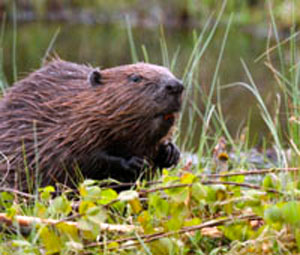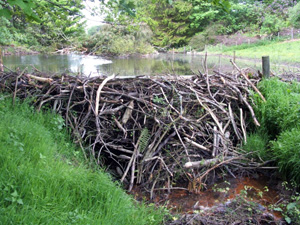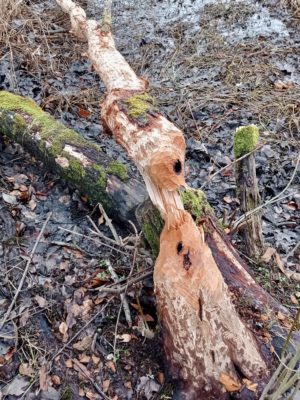Rewilding and beavers.

Rewilding is a term that has been used often by the media recently. Broadly speaking, it refers to the re-introduction of species to areas or habitats where they ‘died out’, in some cases several hundred years ago. The list of animals being considered for rewilding varies, but the elk, wolf, lynx, wild boar, beavers and bears are spoken of as possible candidates.
Bears probably disappeared from the UK sometime in the 12th century, the lynx in mediaeval times, and the last grey wolf was recorded as being killed in Scotland in the 1700s. The loss of such species may be associated in part with hunting but also the loss of forest and the clearance of woodland over the centuries.
It is not certain when beavers disappeared from our landscape; they were hunted for meat and fur until the end of the 16th century. Apart from the occasional escape (and recapture from wildlife parks), beavers have probably been absent for some 400 years, until recently. Now there are small pockets (in Scotland and SW England) where beavers are making a ‘comeback’. Their reappearance is not without controversy.
On the plus side, evidence suggests that beaver dams help prevent flooding - as the regulate water flow during heavy rains and also droughts (according to work of Richard Brazier, University of Exeter). His study involved some six beavers in Devon. Originally, there were two beavers re-introduced and at their  site there was a small stream flowing through deserted woodland. This has been transformed into a ‘rich wetland habitat - with a dozen or so dams, which have profoundly affected the water flow through the system (see New Scientist 21/11/2015). It has been estimated that the series of dams stored some 650,000 litres of water in the heavy rains of last November.
site there was a small stream flowing through deserted woodland. This has been transformed into a ‘rich wetland habitat - with a dozen or so dams, which have profoundly affected the water flow through the system (see New Scientist 21/11/2015). It has been estimated that the series of dams stored some 650,000 litres of water in the heavy rains of last November.
It might be that beaver ‘hydraulic engineering’ could be put to use in the smaller rivers and headwaters of river systems - in order to hold back water during heavy rain / storms. There is also some evidence that the dams filter out various pollutants washed off farms (nitrate and phosphate being a cause for particular concern). The nutrients encouraged mosses and other plants, which in turn attracted insects and amphibians (and birds).
 However, in other places the effects of 'beaver landscaping’ is not so positive! In Scotland, there have been reports that their dams have blocked drainage ditches in agricultural areas. As a result, crops were damaged due to flooding. There were also reports of damage to trees near to roads, and the breaching of anti-flood embankments. There has also been the suggestion that beaver dams could interfere with natural fish populations through interference with the spawning and migration routes. Fishing for trout and salmon fishing contribute to the local economy. Paul Kemp (University of Southampton) has found that fish can benefit from the presence of beavers, this seems to be due (in part) to an increase in gravel areas for spawning. Not unsurprisingly, some farmers are concerned about reintroductions of beavers and want a ‘robust legal framework for the management of the animals’ (NS 21/11/2015).
However, in other places the effects of 'beaver landscaping’ is not so positive! In Scotland, there have been reports that their dams have blocked drainage ditches in agricultural areas. As a result, crops were damaged due to flooding. There were also reports of damage to trees near to roads, and the breaching of anti-flood embankments. There has also been the suggestion that beaver dams could interfere with natural fish populations through interference with the spawning and migration routes. Fishing for trout and salmon fishing contribute to the local economy. Paul Kemp (University of Southampton) has found that fish can benefit from the presence of beavers, this seems to be due (in part) to an increase in gravel areas for spawning. Not unsurprisingly, some farmers are concerned about reintroductions of beavers and want a ‘robust legal framework for the management of the animals’ (NS 21/11/2015).
The fate of the existing beavers and further rewilding will be determined by the Scottish Environment Minister and also deliberations / findings of the the U.K. Environment Agency.
Comments are closed for this post.

There are ways of mitigating the negative impacts of beavers should there be any. Drainage pipes can be inserted in dams to lower the water level, dams can be broken up or in extreme cases, beavers can be moved somewhere else. It is important that prime quality arable land, needed for food production isn’t flooded. There is room for this keystone native species back in our countryside but the attitude of many farmers, and particularly the NFU, is hostile to any change in the way they do things, and that includes to beavers.
Donald McPhillimy
18 December, 2015